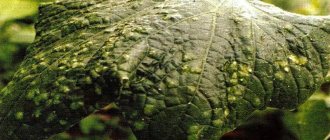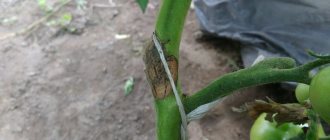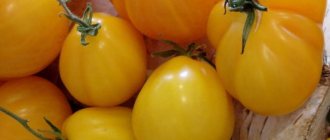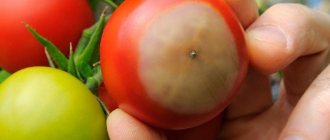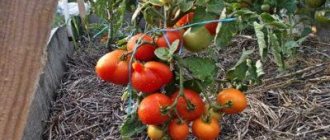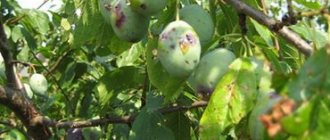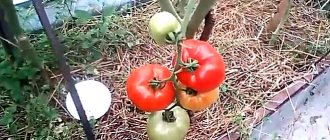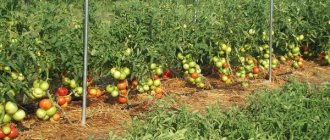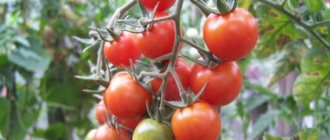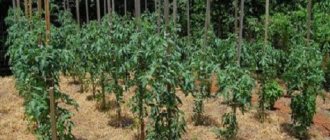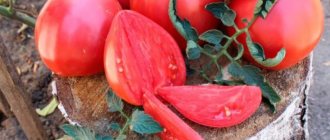One of the most common diseases, the tobacco mosaic virus on tomatoes, destroys the seeds, seedlings and bushes of the plant. The disease is caused by a virus similar to the name Nicotine. Under favorable conditions, the infection spreads quickly and can destroy the entire future harvest.
Tobacco Mosaic Virus on Tomatoes
Seedling plants that have not yet developed sufficiently strong protective mechanisms suffer most from tobacco mosaic. The gardener often carries out various agrotechnical measures with growing seedlings, spreading the virus to seedlings of other crops.
General characteristics of the disease
Tobacco mosaic of tomatoes, treatment of which is carried out when the first symptoms appear, is familiar to every experienced gardener. In most cases, the virus appears in the greenhouse while the seedlings are growing. High humidity creates all the necessary conditions for the rapid spread of the virus. The following may be affected by the disease:
Each virus carrier is a threat to neighboring crops. The infected plant quickly withers and changes the color of the foliage and stems.
The root system is the last to be affected by the virus. Characteristic spots form on tomatoes, which should be combated with homemade (natural) or purchased products (substances with active bacteria that can protect the crop).
Tobacco mosaic on healthy tomatoes occurs in greenhouse conditions or on an open plot of land if the gardener does not follow the rules for carrying out agrotechnical measures: old equipment, unfertilized soil, improper care of plants. The main reasons for the appearance of the virus on tomatoes:
- too dense planting;
- poor ventilation (drafts or insufficient air flow on open land);
- high humidity.
In a greenhouse or garden, incorrect temperature conditions or too high humidity will lead to plant infection with a virus. Tobacco mosaic is determined by a number of symptoms that will be a hint for a novice gardener. If there is a virus on the tomatoes, characteristic yellow dry spots appear on the green leaves and stems. The green part of the tomatoes becomes like a mosaic with dark and light areas.
The sources of the disease are the remains of other plants, soil or infected seedlings. Seeds can infect neighboring crops. Contact method of transmission of the virus is the most common and dangerous. Insects quickly spread the infection to all plants in the greenhouse or garden.
Over time, the virus completely destroys the foliage: deformation of the border leads to drying of the stems and leaves. When the disease is advanced, growths in the form of hard lumps appear on the foliage.
The infection affects the condition of the fruit: tomatoes take a long time to ripen and significantly decrease in size. Gradually, the disease spreads to neighboring crops, and entire rows of planted tomatoes dry out.
How to effectively get rid of tomato mosaic: symptoms and causes of the disease, treatment methods
The main sources of the virus that causes mosaic in tomatoes:
- infected seeds;
- soil with pathogen spores;
- remains of diseased plants.
The spread of infection occurs in this way:
- While caring for plants. The pathogen can be transmitted through the gardener's tools or clothing.
- Through mechanical damage. Violation of the outer protective shell of the plant leads to the fact that the virus can get inside.
- With the help of insect pests. They are present in large numbers in gardens, spreading the infection quite quickly.
- Due to violations of the rules for carrying out agricultural activities.
- infected seed material;
- soil containing spores of a pathogenic fungus;
- plant remains of diseased plants on the site.
Before sowing, disinfect tomato seeds against fungal infections to reduce the possibility of infection.
But the spread of infection is carried out:
- At the time of caring for plants and harvesting fruits. The transmitter is used by gardening tools, clothes and shoes of the gardener.
- In case of mechanical damage to tomato bushes. The slightest violation of the protective shell serves as a gateway for infection.
- Pests and insects. Cicadas, thrips, and aphids present in the garden spread the disease throughout the entire area.
- Violations of agricultural technology for growing tomatoes.
The most favorable conditions for the spread of the disease are insufficient lighting and violations of agricultural technology requirements.
The pathogen remains viable for 22 months, so non-compliance with crop rotation leads to infection of plantings the following year.
The harmfulness of mosaic varies depending on the age, variety and growing conditions of tomatoes on the site.
- excessive watering leading to high soil moisture;
- dense planting of bushes (especially in a greenhouse);
- tightly closed greenhouses (no ventilation).
High humidity, temperature changes, a large amount of plant residues after weeding near the bushes - all this leads to the activation of the virus and infection of the crop.
Lack of disinfection of equipment is another reason for infection of tomatoes. At the same time, through knives and pruners, the infection can spread to other plantings on the site, which will lead to a massive TMV epidemic.
Once in the plant, the pathogen does not always show activity. It is activated when the bush lacks light and when it is weakened due to improper care: too much or insufficient watering, imbalance of fertilizers, temperature changes, etc.
Treatment of the disease
The disease must be treated as quickly as possible
Tobacco mosaic of tomatoes can contribute to other infections. Mixed diseases lead to streaking of tomatoes, which leads to weakening of the stems (the bushes break and dry out).
The fight against the virus begins at the first appearance of yellowness on the foliage. For a good tomato harvest, timely prevention and treatment of leaves, stems and fruits from viral infection is necessary.
Treatment of mosaic on tomatoes begins with the treatment of diseased crops.
For these purposes, prepare a homemade solution: add 100 grams of microfertilizers per liter of whey. The leaves on the tomatoes are carefully processed with the prepared liquid (every leaf must be passed through) and stems. For better processing, use a regular spray bottle.
Treatment of plants from a viral disease is not limited only to treating the bush, but also to cleaning the soil. Soil that is infected with the virus is unsuitable for further planting of seedlings. The top layers of soil are completely removed (up to 15 cm). The new embankment is washed with a concentrated solution of potassium permanganate (proportion with water 1:1) and dried. The renewed soil is fertilized with nitrogen-containing substances and whey.
Prevention
Prevention of tobacco mosaic of tomato will help avoid long-term treatment of the crop and prevent crop destruction. Preventative work includes processing an already healthy bush, seedlings and preparing seeds that are planted in fertilized soil.
Tomato virus infection spreads quickly in greenhouses and humid environments. Constantly ventilating covered rooms and removing moisture accumulated on the walls will eliminate the threat of the virus. The soil for planting seeds and finished seedlings is treated with a weak solution of potassium permanganate. Before planting, the soil is frozen and moistened.
Seedlings with the first signs of disease are removed from the greenhouse and burned. After treating the soil, all equipment is washed and disinfected. Boxes and pots for seedlings are treated for 4 days in a row. For these purposes, a 5% solution of potassium manganese is used.
General disease prevention will protect adult bushes until harvest. Planted seedlings must be vaccinated against the virus (vaccination); 20% hydrochloric acid is used to disinfect seeds, seedlings and bush stems.
Tobacco mosaic is a dangerous viral infection that leads to the death of tomatoes. It can cause loss of up to 50% or more of the crop. The infection is highly contagious and practically untreatable.
Only correct protective measures, timely identification of the disease and destruction of sources are effective against the virus. Therefore, the fight against infection begins long before planting tomatoes.
VTM model
The rod-shaped tobacco mosaic virus was discovered by Adolf Mayer in 1886. No methods have been developed to combat this disease, which largely destroyed food vegetation. And only in 1892, the famous scientist Dmitry Iosifovich Ivanovsky began to study this issue, studying the Nicotiana tobacco variety, which itself died from its own virus. It was he who was able to fully recreate the model of the tobacco mosaic virus: the protein molecule is folded into a helix, the capsid (shell) of which hides a strand of RNA.
The virus has a spiral shell
The scientist has established a certain pattern - a virus molecule can consist of equal-sized spirals, and the larger the turn, the stronger the virus is in terms of infecting plants that are more resistant to it.
Ivanovsky found out that the main sources of infection are not healthy flora, but sick, weak plants and soil. Moreover, he was able to discover a new fact: a hitherto unknown protein passes through a porcelain filter, which was impenetrable to all bacteria known at that time. Such devices were developed specifically to check for the presence of infectious pathogens in liquids. At the first results, he even came to the conclusion that either poison was dissolved in the liquid, or the molecules were so small that they penetrated the filter. Subsequently, it was the second option that was confirmed.
The tobacco mosaic virus contains a single DNA molecule, which contributes to the transmission and improvement of the properties of the disease.
In the vastness of our state, scientists believe that the report on the tobacco mosaic virus by D.I. Ivanovsky confirms the fact that it was he who became the discoverer of this disease. Foreign colleagues are sure that their comrade-in-arms is behind this. Meanwhile, TMV is the first representative of a viral disease that was discovered throughout the world almost simultaneously.
The tobacco mosaic virus infects the leaves and cells of the plant, which causes the destruction of chlorophyll and, as a result, the processes of photosynthesis are much worse and slower.
When damaged, chlorophyll is destroyed and the process of photosynthesis stops
Description of the signs of tobacco mosaic virus:
- the diseased leaf is covered with mosaic stains of an emerald-beige hue;
- the appearance of tubercles due to accelerated cell division;
- the affected TMV segments become spotted, sometimes light or dark green, and resemble a mosaic in appearance.
The tobacco mosaic virus, a photo of which you can see in this article, belongs to the group of viable diseases and can survive in the soil for a long time. It will take several years to clear the soil of this disease. And if we talk about complete disposal of the virus, then the minimum period for eliminating the disease is 4 years. It all depends on weather conditions and the use of effective methods to combat this problem. In a plant cell, the tobacco mosaic virus infects its protective layer, which leads to thinning of the plant. And this, in turn, facilitates the unhindered penetration of bacteria into the culture.
First of all, TMV tries to infect cells that are poor in glucose and organic acids. The infected particle is destroyed, dies, and a chain reaction of chlorophyll destruction begins. Ultimately, the yield decreases, and some fruits remain either underdeveloped or small.
If several different crops are grown in a greenhouse, tomatoes are the first to become infected. Therefore, it is tedious to inspect them first for damage, including other diseases.
VIDEO: Tomato diseases
TMV can be transmitted from a diseased plant to a healthy one through the sap of the first. It can occur when:
- planting seedlings when the seed is already affected by a viral disease;
- the presence in the soil of various kinds of sucking parasitic organisms: mites, nematodes, the saliva of which may contain infection;
- grafting, replanting, removing excess shoots, pinching seedlings or seedlings when speckled grass gets into open areas of shoots and root systems;
- contact of sap from affected vegetation with mechanical equipment for cultivating soil and caring for crops: hoes, shovels, rakes, sprayers, etc.
Tobacco mosaic virus infects the chloroplasts of the following plants:
- tomato;
- cucumber;
- bitter and bell peppers;
- paprika;
- tobacco.
As you can see, this is mostly a nightshade type of vegetation. How to protect yourself from this problem?
It is necessary to prevent the spread of green speck across a plot of land at the stage of selecting seedlings or plants for planting.
Check the leaves carefully before purchasing seedlings
For the purpose of prevention, seeds and containers for growing seedlings must be treated with a 5% solution of potassium permangate. And in order to completely eliminate the appearance of TMV, experts recommend carrying out such disinfection measures for five days. An identical process must be carried out with regard to garden tools.
- vaccination of plants, in particular the cucumber genus and the tomato family, with an aggressive stamp against TMV;
- performing protective procedures when planting crops in greenhouses;
- disinfection of seedlings by keeping them in 20% hydrochloric acid for at least half an hour, after which they are thoroughly washed under running water;
Seedlings will become more resistant to viral infection if they are irrigated with a solution of 1% boric acid a week before planting and two weeks after it. In addition, it is extremely important to carefully process greenhouses, collecting and burning the remains of leaves and roots after harvesting.
- steaming the soil - watering with boiling water for two to three hours;
- treating seedlings once every six days with milk diluted with water in a ratio of 1 to 10;
- timely removal of remaining vegetation on the land plot before planting new ones;
- eliminating sucking insects using all kinds of traps and pesticides;
- disinfection of boxes for seedlings, garden tools used in work;
- replacing the soil in the greenhouse once a year - the procedure is carried out in the spring, in which case it is necessary to remove the top layer of soil (at least 10 cm) and steam it with boiling water;
- spraying plants with serum, adding 3-5 drops of iodine to it;
- heating the seeds at a temperature of 60°C for three days;
- It is better to keep crop seedlings away from tobacco.
When growing crops in a greenhouse, be sure to treat the frame, soil, and internal surfaces in the fall.
When settling on a land plot, VTM cannot be completely eliminated. Therefore, the main task of the landowner is to prevent the possibility of further spread of the viral infection.
Treatment consists of immediately eliminating infected plants and fertilizing the soil with doses higher than normal. It is important to check all seedlings before planting for the presence of green specks, and also after planting in the soil to destroy weeds as they grow.
It is better to give preference not to purchased seeds, but to those collected with your own hands from the land. Moreover, it is extremely important that the vegetables from which the planting material will be collected are healthy.
For a good harvest, give preference to your seeds
By following these recommendations, you will be able to avoid the appearance of green speck on your land.
VIDEO: Tobacco mosaic virus on tomatoes
One of the most common diseases, the tobacco mosaic virus on tomatoes, destroys the seeds, seedlings and bushes of the plant. The disease is caused by a virus similar to the name Nicotine. Under favorable conditions, the infection spreads quickly and can destroy the entire future harvest.
Tobacco Mosaic Virus on Tomatoes
Seedling plants that have not yet developed sufficiently strong protective mechanisms suffer most from tobacco mosaic. The gardener often carries out various agrotechnical measures with growing seedlings, spreading the virus to seedlings of other crops.
Features of tobacco mosaic
Causal agent: Tomato mosaic tobamovirus (ToMV). Previously, this phytopathogen was classified as tobacco mosaic virus (TMV). But even now among vegetable growers and in manuals for agronomists, the more common definition is tobacco mosaic virus (TMV).
The ToMV virus is extremely stable in the external environment. Inactivated only at temperatures above 95°C. The virus is not sensitive to drying. It can survive in dry soils and plant debris for up to 2 years.
The pathogen survives well on gardening tools, greenhouse structures, cigarettes or pipe tobacco. Infection of the plant occurs through damaged epidermal cells and hairs.
The ToMV virus is one of the most contagious (infectious) phytopathogens. The pathogen enters a healthy crop through simple contact. This mainly happens during work on caring for tomatoes (transplanting seedlings, pinching, picking, gartering) even in bushes without visible damage.
The stem and leaves of a tomato are covered with small hairs that break off at the slightest touch. If the plant is infected, TMV viruses with droplets of sap fall on the gardener’s hands or equipment. In exactly the same way, the active virus penetrates the cells of healthy plants. In this case, the microscopic wound becomes an entry gate for the virus.
The rapid spread of the virus is facilitated by dense plantings, drafts and high humidity.
After entering plant cells, the TMV virus begins to multiply and infects chloroplast cells, which leads to the destruction of chlorophylls. There are failures in photosynthesis, disturbances in respiration and other important life processes of tomatoes. The bush slows down in development and gradually dies.
The first signs of infection can be seen on tomato leaves. This is the appearance of a variegated (mosaic) color, where light and dark green-yellow areas alternate.
As the disease progresses, other symptoms occur:
- leaves are deformed;
- the leaf blade becomes wrinkled;
- the fruits become smaller and ripen unevenly;
- yellow spots may appear on the fruits;
- leaves can acquire filamentous or fern-like (rare) forms.
Enation forms on the underside of deformed leaves with thread-like outlines. These are cup-shaped outgrowths with an average size of 1 cm. The appearance of outgrowths - a specific sign of the TMV virus - indicates the development of the most harmful form of mosaic - enational.
Round brown spots with dark edging on tomato leaves
Brown necrosis with a light edge forms on the leaves and stems. A whitish coating is noticeable on the reverse side of the leaf blades in humid weather. The plant dries out. The inside of the fruits becomes covered with brown spots and rots. Diagnosis: late blight of tomatoes is a fungal disease caused by microscopic fungi Phytophthora infestans.
The disease becomes more active in damp weather, and is especially dangerous in the second half of summer, when night temperatures become much lower than daytime readings. Fogs and dew also influence the development of the disease. At risk are tomatoes in open ground and film greenhouses without heating. After the leaves and stems are damaged, late blight spreads to the fruits and makes them unfit for consumption. If signs appear at the beginning of the growing season, complete loss of the crop is possible. The disease spreads very quickly, especially in humid weather.
Phytophthora also affects potatoes, eggplants, sweet peppers and other nightshades.
Spots up to 1.5 cm in length are noticeable on the leaves and stems, sometimes with a black coating. Lesions most often form along the edges of the leaf. Then the spots increase in size and merge. The stems crack and the fruits become pitted with dark, dry spots.
Diagnosis: Alternaria blight, or dry spot, of tomatoes - a fungal disease.
Alternaria blight attacks plants immediately after planting tomato seedlings in open ground or a greenhouse. The fungus loves dry and hot weather, so it is especially dangerous for plants in glass greenhouses and film greenhouses. All parts of the bush are affected, and in the absence of treatment, yield losses amount to up to 85%. Fruits from infected bushes cannot be stored. The disease is easily transmitted to potatoes, and vice versa, so it is better not to plant them next to tomatoes.
Small watery spots appear on old and then young leaves. At first they are not very noticeable, but then they turn white and become covered with a brown edging. The rest of the leaf turns yellow and dries out. The fruits are small and flaccid. Young leaves at the top of the bush are rarely affected.
The leaves on both sides are covered with a white coating. Round spots are located throughout the leaf blade, then merge and darken.
The fruits are covered with softened spots up to 1 cm in diameter. At first they are hardly noticeable and do not differ from the color of the skin. Then they darken and turn black. The fruits are completely mummified. Brown flaky spots are visible on the roots.
Diagnosis: bacterial canker of tomatoes is a disease caused by non-spore-forming aerobic bacteria.
Treatment of tobacco mosaic on tomatoes
There is not a single chemical drug against viral diseases of tomatoes that guarantees a complete cure. After the disease appears on tomatoes, all measures are aimed at protecting healthy bushes.
If signs of infection are detected on at least one bush, all plants are carefully inspected.
Sick tomatoes are immediately removed along with the earthen clod, and the same is done with weeds that grow in the rows.
The practice of vegetable growers has proven that pruning damaged parts of tomatoes followed by treatment does not lead to results. A diseased plant becomes a dangerous source of the virus and can cause epiphytotics.
The soil is thoroughly cleaned of fragments of roots and other parts of tomatoes. All plant residues are burned. If reserve seedlings are planted in this place, the soil is completely changed. Spill with a 5% solution of potassium permanganate, dry and fertilize with nitrogen.
Healthy tomatoes are treated with a whey solution:
- whey (skim milk, low-fat kefir) - 1 l;
- urea - 1 tbsp. l.;
- water - 10 l;
- grated soap - 40 g.
Solution temperature 22-24°C. Tomatoes are completely sprayed with a spray bottle, be sure to spill the soil in the circle around the trunk. Instead of urea, you can add 4-5 drops of iodine to this solution.
In infected tomatoes, the absorption of minerals from the soil is significantly reduced: boron, magnesium, iron, manganese and zinc. This leads to significant weakening of plants, rapid spread of the virus and death of tomatoes.
Feeding tomatoes leaf by leaf with microelements (boron, manganese, zinc, copper, iron) inhibits the manifestation of TMV symptoms in weakly affected plants (without visible signs). This allows you to increase the tomato yield by 30%.
Soil treatment after tomatoes
The accumulation of the virus in the soil is facilitated by growing crops in the same place. Therefore, the place under the tomatoes in the open ground is changed annually, returning them back only after 3-4 cycles.
Organizing crop rotation in a greenhouse is much more difficult. Here the problem is solved by completely replacing the soil and, if growing tomatoes is combined with cucumbers, changing their places.
In any case, immediately after harvesting, all plant and root residues are raked and burned. The soil is dug deeply, mineral fertilizers are applied according to the requirements of the successor crop.
In spring, the soil is treated with a 2% solution of 40% formaldehyde, shedding the soil until it is completely wet. Then cover with film and leave for 3 days. The same solution is used to treat greenhouse structures.
Preventive spraying of seedlings
Protective spraying of plants begins while growing seedlings. To do this, 1 liter of whey, low-fat kefir or skim milk is diluted in 10 liters of warm water.
The work is carried out with a home sprayer, completely wetting the leaves and stems of the tomatoes. As a result, a thin film is formed on the surface of plants, which prevents the contact spread of the virus.
The first treatment is carried out the day before picking, the last - the day before planting the seedlings in the ground. The interval between spraying should not exceed 8 days.
5-7 days before planting seedlings, spray with a 0.05% solution of boric acid.
During the season, tomatoes are sprayed 4 times with solutions:
- 0.05% boric acid;
- 0.01% cobalt nitrate;
- 0.01% copper sulfate.
Treatment is carried out in the evening hours with an interval of 15-20 days.
How to deal with tomato mosaic
Any viral diseases of tomatoes are easier to prevent than to cure. Only prevention helps to completely protect yourself from crop loss. First of all, this is the choice of a virus-resistant tomato variety.
Homemade seeds and seeds from dubious sources must be disinfected. To do this, they are immersed in any of the solutions: 20% hydrochloric acid, 10% trisodium phosphate, 1% potassium permanganate - for 30 minutes. Wash under running water and dry in the sun.
All seedling containers are disinfected with a 5% solution of potassium permanganate or a 2% solution of formaldehyde. Before planting seedlings, plants with mosaic symptoms are discarded.
During pinching and pruning, all equipment is disinfected before processing each bush. To do this, use alcohol, skim milk, 5% solution of potassium permanganate, 5% solution of ferrous sulfate. It is advisable to treat your hands as well.
For tomato varieties and hybrids that are susceptible (not necessary for those that are resistant) to the TMV virus, vaccination is carried out. For this purpose, drugs based on weakened strains of the q-7 or v-69 virus are used. Treatment is carried out 8-10 days after emergence.
To do this, freshly cut wormwood grass is crushed, filled with half a bucket, filled with water and left for a day. Then boil on fire for 30 minutes. Strain and bring the volume to 10 liters.
To prepare a pine infusion, 2 kg of pine needles are poured into 10 liters of water, left for 7 days, filtered and brought to the original volume. You can purchase pine concentrate. It is diluted with water in a ratio of 1:7.
All season long, tomatoes provide balanced nutrition on demand. Potash fertilizers especially increase plant resistance to the virus. To prevent weakening of the crop, optimal temperature and soil conditions are maintained.
In the video you can see what leaves and fruits affected by tobacco mosaic look like, learn about the causes and methods of prevention.
How to recognize the disease and its manifestations
Mosaic is a disease whose main characteristics are green and white spots on leaves and fruits. They come in different sizes and shapes and cause leaf damage and changes in their contour.
Seedlings affected by infection slow down their development and growth, and adult plants gradually wither and die. Before the characteristic spots appear, entire fields can be completely infested.
History of appearance
At the end of the 19th century, the first symptoms were discovered on tobacco plantations. At first, one bush was infected, it became covered with bright marks, lost its shape and eventually died. Gradually, one after another, neighboring ones fell ill, and soon, entire plantations were unsuitable for further tobacco production.
The only way to combat it at that time was to destroy infected seedlings at the first manifestations in order to preserve the rest. The disease is called “tobacco mosaic.” Only a century later, Dr. Ivanovsky D.I. A virus has been discovered that causes mosaic plant disease.
What caused
Mosaic completely affects tissues at the cellular level. Occurs as a result of damage to chloroplasts and partial destruction of chlorophyll. Plastids disintegrate, resulting in a decrease in carbohydrate levels. The death of individual tissue sections begins. The pathogens named are Nicotina virus 1, Cummis virus 2, Solanum virus 1 and many others.
Mosaic plant disease
How it manifests itself
There are many viruses that only infect certain varieties. In garden crops, mosaic can be expressed in different ways. The first manifestations characteristic of it are:
- Spots of different colors and sizes: can be light yellow, bright green or whitish. They have an irregular shape and deform the structure of the leaf plate.
- The development of the crop slows down in comparison with others, water metabolism is disrupted, which is why the stems and leaves dry out. First of all, this concerns young shoots.
- Brown marks on vegetables and fruits. Due to damage, the process of rotting begins, so they become partially or completely unsuitable for food.
How it spreads
Infection can occur due to mechanical damage during processing or normal contact with infected crops. This often happens when picking dense seedlings. But the disease can also be transmitted by the wind touching leaves or stems together.
Trimming or breaking off infected leaves or stems is not recommended, as the sap will remain on the blade and hands. With further work on the site, there is a possibility of multiple infections.
The disease can be spread by vectors. They can be insects such as aphids, mites, bedbugs, etc. Mosaic is also transmitted through fruits and seeds carried by birds and animals.
Methods of spreading mosaics by insects
The soil beneath the root is a breeding ground for infection because it may contain plant debris such as fallen leaves. High humidity and air temperature +20-25°C contribute to the development of mosaic infection.
Spread can also occur through raindrops running down an infected plant containing small particles of diseased plants.
Tomato hybrids resistant to the virus
Tomato resistance to TMV is determined by 3 types of genes: Tm-1, Tm-2, Tm-2 2 . The disease on immune hybrids develops only under a combination of a number of conditions: a high infectious load, an air temperature of more than +28°C and strong sunshine for 5-7 days.
Resistant hybrids (F1):
Infection in relatively resistant hybrids is manifested by a yellow mosaic on the upper leaves, systemic necrosis and streaking (roughness) of the fruit.
The main mistake of many vegetable growers is not taking plant diseases seriously: it doesn’t seem to matter that they harvested a small crop this year. But it should be remembered that almost all pathogens of tomato diseases can survive in the soil and other surfaces for a long time.
As a result, a huge supply of infection forms on the site, the elimination of which will require a significant expenditure of time and money. There are no harvests in such gardens. Therefore, it is important to fight potential diseases regularly, even if there are no infected plants in the dacha.
The disease with the beautiful name mosaic is actually an insidious virus that rages especially often in the northern regions of the country. Not only does it spoil the leaves, but the crop also becomes smaller, loses its taste, and ripens poorly.
Reviews from gardeners
Irina, Kursk
The bushiness of the top, threadlike and fern-like leaves are preserved on tomato seeds, on the surface of which it is sorbed, as well as in many wintering weeds. It is necessary to destroy the weeds around, preventing sucking pests such as aphids from developing. And do not use the same varieties of tomatoes, especially in years affected by diseases or viruses.
Source: frauflora.ru
Oleg, Kaliningrad
In spring, winged aphids feed on diseased perennials. When annual plants emerge, insects fly to them, carrying the infected sap on their mouthparts. If plants are susceptible to the virus, infection occurs.
Source: forum.prihoz.ru
Virus biology
There are several strains of the virus with different properties. The disease parasitizes only tomatoes and is abbreviated as ToMV in international classifiers. It is caused by the Tomato mosaic tobamovirus virus. Tobacco mosaic virus on tomatoes affects nightshade and nicotine crops, it is called Tobacco mosaic virus, abbreviated as TMV. In addition, cucumber mosaic can cause similar symptoms.
It has a rod-shaped virion, which dies at a temperature not lower than +93 degrees and an exposure period of at least 10 minutes. It lives in diseased plants for 4-6 weeks, and if the juice is stored under sterile conditions, it lasts up to 5 years.
When bacteria get on plants, they penetrate cells and irreversibly change them. The fruits and bushes become covered with spots, dead areas and fibers appear in them, the crop loses its taste and development stops.
If the disease hits a bush that is already infected with the potato virus X, a streak develops - an incurable disease with an even more rapid progression.
Symptoms
In the first week, the stems may wilt, but when the temperature drops, they recover. Then bright symptoms appear:
- Light specks appear on the bushes, which increase in size and turn into a mosaic spotting of light green and dark green shades.
- The stems wrinkle, become deformed, and can become thread-like.
- Thread-like leaves have cup-shaped or ear-shaped tubercles on the underside (they are called enation, and enation mosaic is considered one of the most dangerous subspecies).
- The fruits become smaller and ripen unevenly.
- Dark gray-green areas appear inside the eggs; over time, they die and partial necrosis develops.
- Bunches of dead blood vessels are visible through the skin in the form of a brown mesh.
Signs
Symptoms of mosaic in tomatoes can vary. It depends on the degree of infection, the type of disease, and growing conditions.
The main signs of mosaic disease in tomatoes are as follows:
- Withering. This process is observed in the first seven days after infection.
- Loss of elasticity. This symptom is observed when intensive plant growth occurs during a period of significant solar radiation. After a cold snap, the plant recovers.
- Change of color. It can range from pale or colorless to bright yellow and green. In this case, well-defined areas of affected tissue can be seen on vegetables.
- Folding. The leaf blades grow unevenly. This process is more intense in the upper part of the plant.
Other common symptoms of mosaic include deformed leaves. Often their plates are reduced to such a size that the bush can become like a fern. Some parts of it resemble long threads.
Darkening appears inside the fruit. As a rule, it appears near the calyx of the fruit in the form of gray-green areas. Subsequently, these areas grow, including the top of the fruit. Following this, tissue death occurs. This process leads to the appearance of a brown mesh on the fruit. It is clearly visible through the skin of tomatoes.
Spreading
Bushes can become infected:
- through gardening tools, especially pruning scissors and other objects that damage the integrity of leaves and cause wounds;
- through the clothes and shoes of the gardener (the virus can even remain on the hands in the sap of diseased plants);
- for any mechanical damage to the bushes, even minor;
- through the bites of insects that feed on sap - leafhoppers, aphids, thrips;
- due to non-compliance with crop rotation and other violations of agricultural technology.
Treatment methods
Gardeners who have diagnosed the disease in their garden beds are interested in how to combat the disease in greenhouses. However, it is impossible to cure an already diseased bush with serious damage. Control methods include pruning the affected parts of the plant at the first sign of disease, removing and destroying bushes with late stages of infection, and then treating to protect the remaining plantings.
It is believed that potassium is effective against illness in greenhouses. It will help rather for prevention: they fertilize tomatoes with it and reduce the amount of nitrogen fertilizers. The mineral permanganate is used to treat soil and seeds.
Having gotten rid of diseased bushes, healthy ones and those in the early stages of the disease are sprayed with a solution of 1 liter of milk or whey in 10 liters of water. Treat weekly until the leaves acquire a normal shade.
Prepare a 0.05% solution of the drug and spray the beds.
75 g of the drug powder is dissolved in 10 liters of water. Treat the entire bush and repeat after 10 days. The remedy is effective in the early stages.
Prepare a solution of milk and water in a ratio of 1:10, pour in 10 drops of iodine.
Spray tomatoes at weekly intervals.
They are prepared according to the instructions and process the plants while wearing glasses and gloves.
Carry out preventive measures
Do not plant plants that carry the virus next to each other When planning plantings, place crops correctly
You cannot plant cucumbers, zucchini and pumpkin next to each other; these are the most dangerous plants in terms of infection.
If there is no other possibility, then plant these crops with a number of precautions. Treat their seeds well and periodically carefully inspect the crops
Carry out weeding at least twice a month Destroy all weeds
This significantly reduces the likelihood of tomatoes becoming infected. Carry out work constantly so that weeds do not grow and are destroyed while they are still small and easy to weed out.
Removing weeds by the roots It is important not just to cut off their above-ground part, but to weed out and remove them completely. At the same time, do not leave plant residues on the site; they should be taken outside the beds
Use a high-quality soil mixture. It is best to purchase ready-made substrates. They are processed appropriately and contain almost no pathogens.
')); (w||(w=[]))&&w.push({id:b,block:'14502'});})(window,document,"mtzBlocks");
The compositions should be used for both adult plants and seedlings. It is important to change them periodically, since various pathogenic microorganisms tend to accumulate in the soil year after year
Disinfect the soil every spring If the soil has not been used for the first year or you are planting plants in the soil in the garden bed, you should treat it. To do this, the water is brought to a boil, after which potassium permanganate is dissolved in it (the solution should be deep pink). Water the soil with hot water. Treat the surface generously and let it sit for at least 3 days. If you plant seedlings the next day, the root system will get burned
Treat tomatoes with Pharmaiod. Use a special disinfectant composition with iodine. It strengthens the immunity of tomatoes and makes them more resistant to cucumber mosaic. Use it in proportions and at intervals recommended in the instructions. If there is no special solution, you can use regular iodine. It is diluted in warm water in the proportion of 10-15 drops per bucket. It should be applied to healthy plants for preventive purposes at least once a month.
Use resistant hybrids The packaging always contains information about the resistance of a particular variety to various diseases. You should choose those options that have increased resistance to viral diseases. It is worth remembering that sustainability does not mean complete safety. If agricultural practices are violated and favorable conditions for infection are created, the disease can occur over time
Destroy aphids on the site. It is best to use special chemicals, as in the photo. They are much more effective and act quickly. But before you fight aphids, you should study the instructions in order to understand what period of time you cannot remove fruits from plants.
You can use folk remedies. This is a decoction of onion peels, tobacco dust, wormwood and other plants with a strong odor. But for a normal effect, such treatments need to be repeated once every 2 weeks.
Prevention
Standard measures will protect the plant from viruses, fungi and bacterial infections:
- Before planting, you need to soak the seeds in a weak solution of potassium permanganate (1-2%) for an hour or two.
- The soil for seedlings is roasted in the oven at a temperature not lower than +90, and optimally - +110 degrees.
- The soil in the beds is spilled with boiling water, in which a little potassium permanganate is dissolved, or with a solution of boric acid - 1 tsp. powder per 10 liters of water.
- They observe crop rotation and do not grow nightshade crops for several years in a row in one plot or in beds after other nightshade crops and cucumbers.
- Do not thicken the plantings, leaving a distance of 40-50 cm between the bushes.
- Tools are regularly washed and disinfected, and at the end of the season - all surfaces of the greenhouse.
- To protect against insect carriers of infection, marigolds, basil or other strong-smelling plants are planted near the tomatoes.
In spring and summer, tomatoes can be attacked by various viruses and diseases. In addition to the well-known late blight, mosaic is considered another scourge for culture. The disease is considered viral and very quickly leads to the death of tomatoes, especially if left untreated. At the first signs, it is necessary to urgently take treatment measures to preserve the harvest.
Description and symptoms
The causative agent of the disease is the Tomato mosaic tobamovirus virus. Infection with the disease occurs mainly through the soil, from neighboring crops (potatoes, cucumbers). The carriers of mosaics are often insects: mites, aphids, beetles. The virus can be transmitted to plants from infected planting seeds. Once an infection hits tomatoes, defective fruits of an ugly shape and with rotten pulp are formed, and the tomato bushes themselves wither and die over time. The yield is reduced by at least 50%.
The first signs of the disease appear a few days after infection. The main symptom is the appearance of clearly visible inclusions on the leaves, which have a bright border. The spots can be of various shapes and sizes. The leaves begin to stretch and curl. Then the stem and leaves begin to dry out, and the disease quickly attacks neighboring plants. On fruits, the mosaic appears as light green and white spots. The tomato pulp of infected fruits begins to turn black and rot. These tomatoes are no longer suitable for human consumption.
The following factors aggravate the course of the disease:
- high ambient temperature;
- increased air humidity and dampness;
- excess nitrogen fertilizers;
- lack of light.
Mosaic comes in several types: tobacco, ordinary, green and white. Tobacco and common mosaics appear as light spots, but in the first type of disease the spots develop into bumps. Green and white varieties, as the name suggests, form splashes of corresponding colors. Otherwise, the diseases are similar and are equally dangerous for tomatoes.
Which plants are susceptible to infection?
The virus penetrates healthy cultures through the contact of the patient’s juice with healthy ones, this happens when:
- Planting seeds from previously infected fruit.
- Through the entry of infected vectors of mites, nematodes, aphids, and bugs onto the plant.
- When planting, pinching, vegetative propagation, when there is a high probability of infection getting directly to the plant.
- Penetration of infected juice onto garden equipment, and subsequently onto vegetable crops, by mechanical means.
- In case of accidental injury to the plant.
- When transferring pollen.
This infection combines well with other viruses and becomes destructive as the plant begins to rot and dry out.
The main plants that suffer from this virus are nightshades. It is also seen on blooming indoor flowers.
The virus is stored on plants for a long time; even winter frosts are unable to destroy it.
It is believed that it was the study of TMV that laid the foundation for the science of virology.
Treatment
Once the virus has entered the plant, it progresses every day, so there is no need to delay treatment. Treatment is difficult, since the disease is resistant to low and high temperatures; in severe stages it is pointless to resist the mosaic.
If spots appear on the leaves, especially on young shoots, they are immediately isolated from other bushes. Infected shoots are cut to a healthy place; the cut area must be treated with a solution of potassium permanganate or hydrogen peroxide. A pharmaceutical solution of chlorhexidine is suitable for disinfection.
If the disease has just begun to spread throughout the plant, a special substance, karbofos, is used for treatment. It has an antimicrobial effect and prevents the formation of pathogenic microflora on healthy plants. For 10 liters of water you will need 75 grams of powder. The drug is diluted and applied to the shoots and stems of tomatoes. To consolidate the result, repeat irrigation after 10 days.
Important!
Shoots already infected with mosaic cannot be restored; they are cut off and burned.
At the initial stage, treatment can be done with a mixture of milk and iodine. Dilute 1 liter of milk in 10 liters of water and add 10 drops of iodine. Tomato bushes are irrigated with the prepared solution. Repeat treatment after a week. Iodine has antibacterial properties, and milk promotes the development of beneficial bacteria that resist the virus.
The disease can be defeated at an early stage of development if you use fungicides - substances containing chemical compounds that lead to the death of most viruses, including mosaic. The drugs Maxim and Lamador are considered effective fungicides. Supplements must be diluted strictly according to the instructions. Since they contain harmful chemical compounds, when preparing the solution and processing plants, you need to use protective equipment: gloves and goggles.
